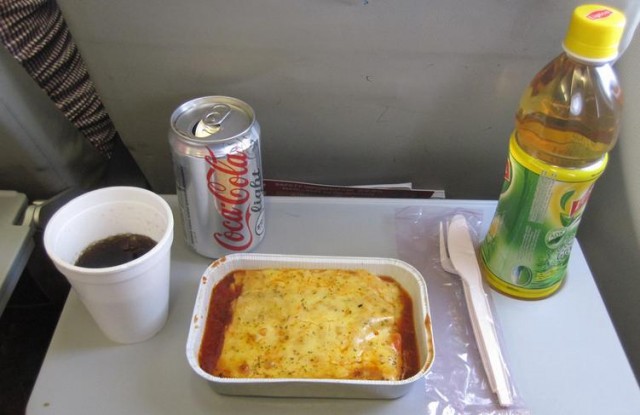Eating on Airplanes

I flew on American Airlines during a recent trip and decided to order something to eat. The flight attendant said I could choose between fruit and cheese, a caesar salad, and a chicken sandwich, and I chose the sandwich, which she handed to me after swiping my credit card. The sandwich was actually a wrap filled with chicken in some kind of mayonnaise — not particularly tasty, but I ate it and wasn’t hungry for the rest of the flight.
Why is airplane food often so bad?
Our pal Julie Beck looks into the history of food served on airplanes (multi-course meals used to be served with items that included prime rib and lobster), and why airplane food isn’t as good as it used to be. As it turns out, the mayonnaise in that chicken wrap was there with a purpose:
Today’s planes, which reach altitudes of 35,000 feet or more, are pressurized so you only feel like you’re about 6,000 to 8,000 feet above sea level. This helps keep you, you know, breathing at those high altitudes, but it also numbs your taste buds, making food taste blander. Older aircraft didn’t fly as high, meaning the prime cuts of steak being served on those early flights tasted more like they would have on the ground.
Other aspects of the airplane environment make it less than gastronomically ideal — cabin humidity is typically lower than 20 percent (as opposed to the 30 percent or more that is normal in homes), which can dry out your nose, weakening your sense of smell. And smell is inextricably linked to taste. (The dryness of the cabin makes you thirsty, too.) Also, the air in the cabin is recycled about every two to three minutes. That, plus air conditioning, can dry up and cool down food very quickly, according to de Syon.
“If you were to serve a nice breast of chicken, which you can do on board, within a minute or two, the chicken would be like sawdust,” he says.
The solution is in the sauce.
It’s all very fascinating.
Okay, now someone explain hospital food next.
Photo: Rolling Okie
Support The Billfold
The Billfold continues to exist thanks to support from our readers. Help us continue to do our work by making a monthly pledge on Patreon or a one-time-only contribution through PayPal.
Comments